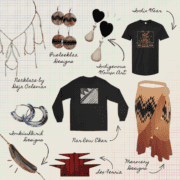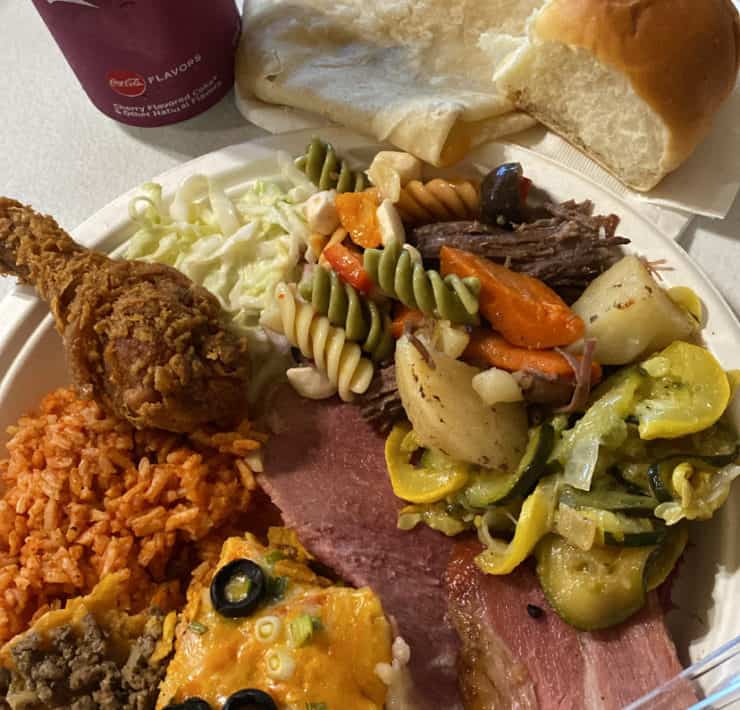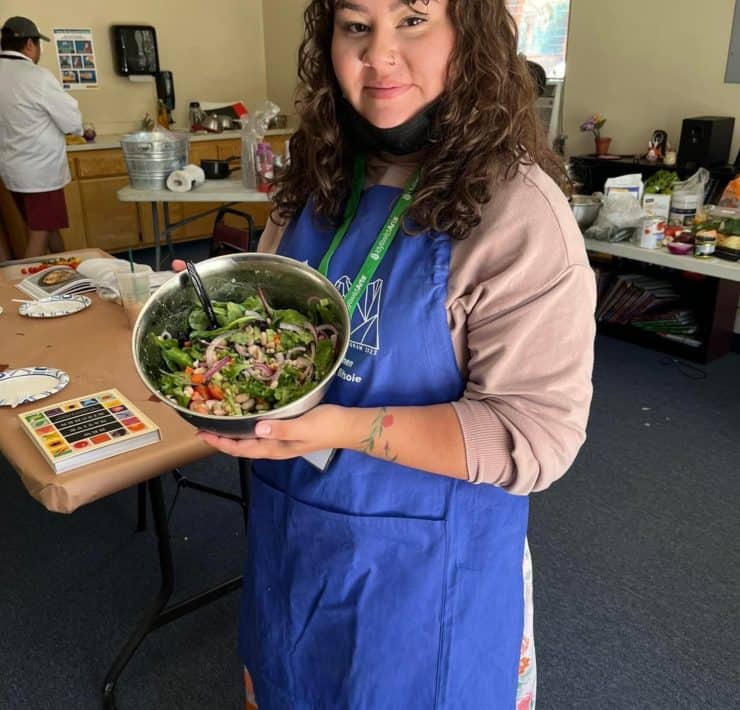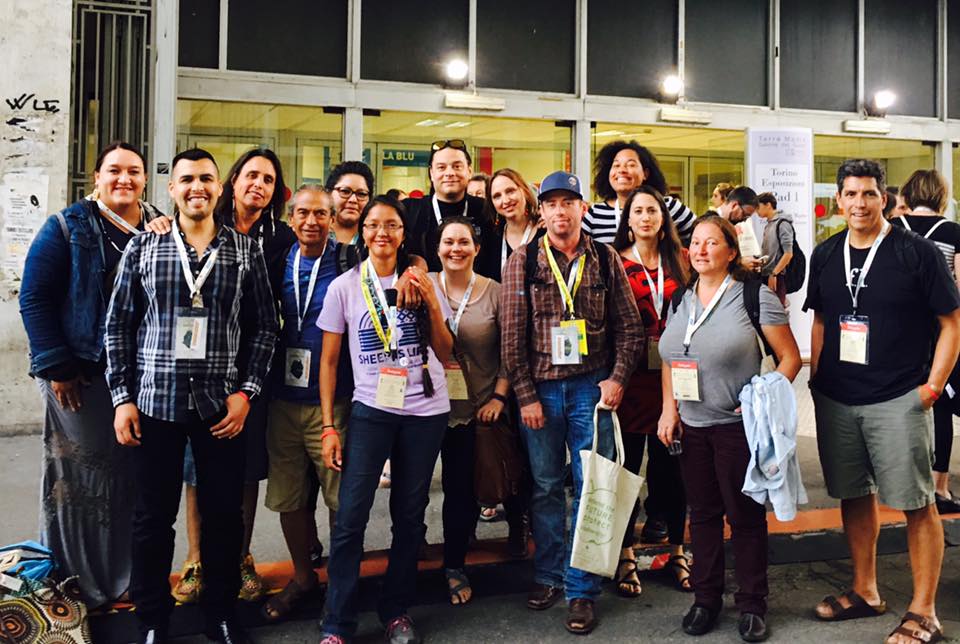
Review by Ishmael Alikhan Elias
I’ve been to Wahpepah’s Kitchen twice this month. Before then, I hadn’t been to Fruitvale Station since January 2009 when protests broke out over the shooting of Oscar Grant. I thought about this as my wife and I walked on a cool, sunny day through the renovated Fruitvale Village on our way to the restaurant. A woman shouting through a megaphone across the street took me further down the rabbit hole of Bay Area activism—The Black Panther Party, The Occupation of Alcatraz, and, more recently, Decolonize Oakland. As we neared the restaurant, hearing the music of contemporary Native musicians pumping from the speakers inside and seeing stylized “Native American Owned” text painted on the windows, I realized Wahpepah’s Kitchen is also activism.
“This is land back in a different way,” owner and chef Crystal Wahpepah (Kickapoo) said on the subject during a chat at our table outside the restaurant. “If we don’t have these places, [Native food sovereignty] will be gone.” Our order of blue corn maple cornbread, buffalo kabobs, sweet potato tostada, Kickapoo bison chili, and blue corn mush had been served by that time. I looked at the dishes as she spoke, taking in the weight of her statement as well as the colorful display of the foods before us.

Wahpepah pointed behind me, toward the BART station, and said she went to school a few blocks away. She said while growing up in Oakland, on Ohlone land, she noticed there were no representations of Native foods in the wider community, though she did cook with her grandmothers and aunties. She gestured toward a dish, “This is my grandmother.” She gestured toward another, “This is my grandfather.” As I thought about the significance of her being at the vanguard of Indigenous food representation in her hometown and all the obstacles she must have overcome along the way, she then gestured toward the bowl of blue corn mush—zhuzhed up with seeds, fruit, maple syrup, and chia seeds—and said with a hearty laugh, “We had this growing up, but it didn’t look like that.”
This led to a conversation about food sourcing. The ingredients for her dishes come from local farmers, ranchers, and other Indigenous food vendors she has built relationships with throughout Indian Country. For example, some of her dry goods come from Sakari Farms in Oregon, corn from Ramona Farms in Arizona, and smoked salmon from the Lehmi Nation.
Wahpepah’s Kitchen is indeed a celebration of Native cultural diversity and unity. Looking into the restaurant, Wahpepah directed our attention to the mural painted by Navajo artist Tony Abeyta, which features squashes, gourds, and long cornstalks resting against a sky of various shades of blue. She then mentioned the red mural-in-progress by Native art collective NSRGNTS on the wall behind Abeyta’s, saying it represented Native trade routes through food sovereignty. Precolonial, I thought. Decolonial. Once the mural is complete, she said, there will be five characters, each holding a food from their region: an Aymara man with potatoes, a Maya woman with corn, a Kickapoo woman with squash, an Ohlone woman with acorns and berries, and a Lakota man with bison meat. A reveal of the finished project will be held in a few weeks, she added.
I asked if her menu being seasonal was an issue during the pandemic, especially with recent supply chain shortages. She nodded and said she definitely had to make adjustments during the pandemic, especially given that her restaurant is in its infancy. She compared the opening to “birthing a baby.” My wife asked Wahpepah if she planned to expand the catering side of her business to which Wahpepah replied she’s been selective about catering work and would not expand operations “until our baby can walk.”


Wahpepah said the Covid-19 pandemic shut down her ability to cater and eventually wiped out her commercial kitchen space in downtown Oakland. She asked herself, “What am I going to do?” In response, she made individual food items available for shipping. This included developing a wild rice amaranth energy bar along with chocolate chokecherry and chocolate rose hips flavors. She stressed opening a restaurant was a major lift due to business negotiations, pandemic pressures, the rising costs of commercial spaces, and finding a place that was the right fit. She had been looking for over a year and a half until she landed at her current location, the former site of the famed Reem’s Bakery. Wahpepah said it was chef Reem Assil, the owner of Reem’s, who reached out to her after hearing word of Wahpepah’s search.
I asked what was the major difference between a commercial kitchen and a restaurant. Wahpepah said a commercial kitchen is for demonstrations and catering operations whereas a restaurant is for serving customers, which is a learning process. She said her core mission was still the same, however: promoting Native food sovereignty, educating communities and organizations about the benefits of Indigenous foodways, and providing health and wellness to the community.
With that in mind, I noted there was no fry bread on the menu. Wahpepah said she eats fry bread maybe once a year, but she wants to make foods that don’t make people say, “Ugh, I want to take a nap!” I laughed and mentioned the fry bread comas my wife and I experienced during pandemic quarantine. “You can have fry bread. You can have birthday cake (for example), but not all the time,” she added. She said due to her family being from Oklahoma, she ate a lot of venison, but added, as she looked at the bison kabobs on the table, that bison was the leaner meat.
Wahpepah said she considers herself and her multi-tribal staff to be “Indigenous warriors on the frontlines, reclaiming Indigenous foods.” She said providing healthy, Native foods was her way of showing up for the community. She said it is “different work,” but crucial.
With that, she suggested we eat before the food got cold. She bid us adieu and we happily followed her directive.
As with our first trip, my wife and I commented on how fresh and light everything tasted, yet there was an undeniable heartiness to it all. Reclaiming and reinventing, I thought. I’ve eaten all the types of food we were served that day, but never with the culinary accoutrements, layered flavors, and presentation. Not only were we tasting Wahpepah’s experience as a chef, but also the culture and tradition passed down to her through generations. Fighting the good fight, I thought, one dish at a time.
Near the end of our meal, Wahpepah graciously brought out an acorn cookie for us to eat or take home to our daughter (who had come for our first visit). My wife laughed and said the cookie most likely wouldn’t make it home. She was right.

Visit wahpepahskitchen.com for more information including location and hours.








